
Amaryllis is the only genus in the subtribe Amaryllidinae. It is a small genus of flowering bulbs, with two species. The better known of the two, Amaryllis belladonna, is a native of the Western Cape region of South Africa, particularly the rocky southwest area between the Olifants River Valley and Knysna. For many years there was confusion among botanists over the generic names Amaryllis and Hippeastrum, one result of which is that the common name "amaryllis" is mainly used for cultivars of the genus Hippeastrum, widely sold in the winter months for their ability to bloom indoors. Plants of the genus Amaryllis are known as belladonna lily, Jersey lily, naked lady, amarillo, Easter lily in Southern Australia or, in South Africa, March lily due to its propensity to flower around March. This is one of numerous genera with the common name "lily" due to their flower shape and growth habit. However, they are only distantly related to the true lily, Lilium. In the Victorian Language of Flowers, amaryllis means "pride, determination and radiant beauty".
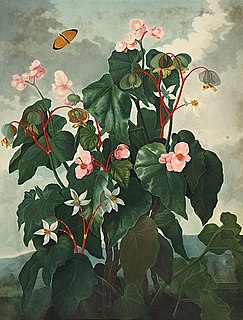
Begonia is a genus of perennial flowering plants in the family Begoniaceae. The genus contains more than 1,800 different plant species. The Begonias are native to moist subtropical and tropical climates. Some species are commonly grown indoors as ornamental houseplants in cooler climates. In cooler climates some species are cultivated outside in summertime for their bright colorful flowers, which have sepals but no petals.
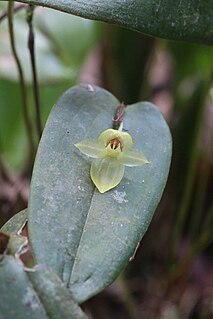
Pleurothallis is a genus of orchids commonly called bonnet orchids. The genus name is derived from the Greek word pleurothallos, meaning "riblike branches". This refers to the rib-like stems of many species. The genus is often abbreviated as "Pths" in horticultural trade.

Goldenrod is a common name for many species of flowering plants in the sunflower family, Asteraceae, commonly in reference to the genus Solidago.

The genus Pulsatilla contains about 40 species of herbaceous perennials native to meadows and prairies of North America, Europe, and Asia. Derived from the Hebrew word for Passover, "pasakh", the common name pasque flower, refers to the Easter (Passover) flowering period, in the spring. Common names include pasque flower, wind flower, prairie crocus, Easter flower, and meadow anemone. Several species are valued ornamentals because of their finely-dissected leaves, solitary bell-shaped flowers, and plumed seed heads. The showy part of the flower consists of sepals, not petals.

Bombax is a genus of mainly tropical trees in the mallow family. They are native to western Africa, the Indian subcontinent, Southeast Asia, and the subtropical regions of East Asia and northern Australia. It is distinguished from the genus Ceiba, which has whiter flowers.

Potentilla indica known commonly as mock strawberry, Indian-strawberry, or false strawberry, is a flowering plant in the family Rosaceae. It has foliage and an aggregate accessory fruit similar to that of a true strawberry. It has yellow flowers, unlike the white or slightly pink flowers of true strawberries. It is native to eastern and southern Asia, but has been introduced to many other areas as a medicinal and an ornamental plant, subsequently naturalizing in many regions worldwide.

Goodenia is a genus of about two hundred species of flowering plants in the family Goodeniaceae. Plants in this genus are herbs or shrubs, mostly endemic to Australia. The leaves are variably-shaped, the flowers arranged in small groups, with three or five sepals, the corolla bilaterally symmetrical and either fan-shaped with two "lips" or tube-shaped. The petals are usually yellow to white, the stamens free from each other and the fruit a capsule.
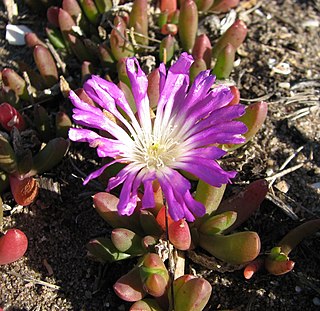
Disphyma is a genus of flowering plants in the family Aizoaceae that are native to New Zealand, Australia and southern Africa. Plants in this genus are prostrate, annual or short-lived perennial shrubs with succulent leaves and daisy-like flowers arranged singly on the ends of shoots with petal-like staminodes, many stamens and usually five styles.
The Plant List is a list of botanical names of species of plants created by the Royal Botanic Gardens, Kew and the Missouri Botanical Garden and launched in 2010. It was intended to be a comprehensive record of all known names of plant species over time, and was produced in response to Target 1 of the 2002-2010 Global Strategy for Plant Conservation, to produce "An online flora of all known plants.” It has not been updated since 2013, and is superseded by World Flora Online.
Catalepidia is a genus of a sole described species of medium-sized trees, constituting part of the plant family Proteaceae. The species Catalepidia heyana grows naturally only in a restricted mountain region (endemic) of the wet tropics rain forests of north-eastern Queensland, Australia. Common names include Hey's nut or Hey's nut oak.
Sphalmium is a monotypic genus of flowering plants in the protea family. The only species, Sphalmium racemosum, is a large forest tree. Common names include satin silky oak, mystery oak, Mt Lewis oak, poorman's fishtail oak and buff silky oak.

The Interim Register of Marine and Nonmarine Genera (IRMNG) is a taxonomic database which attempts to cover published genus names for all domains of life from 1753 in zoology up to the present, arranged in a single, internally consistent taxonomic hierarchy, for the benefit of Biodiversity Informatics initiatives plus general users of biodiversity (taxonomic) information. In addition to containing over 490,000 published genus name instances as at March 2020, the database holds over 1.7 million species names, although this component of the data is not maintained in as current or complete state as the genus-level holdings. IRMNG can be queried online for access to the latest version of the dataset and is also made available as periodic snapshots or data dumps for import/upload into other systems as desired.
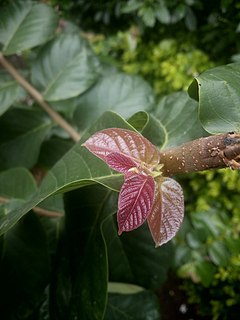
Holoptelea integrifolia, the Indian elm or jungle cork tree, is a species of elm native to most of Indian subcontinent, Indo-China and Myanmar. It is found mostly on plains but also in mountains on elevations up to 1100 m.

Protea namaquana, also known as the Kamiesberg sugarbush, is a flowering plant which belongs to the genus Protea. The plant is endemic to the southwestern Cape Region of South Africa, in particular the Kamiesberg mountains of Namaqualand in the Northern Cape province. The species has a worldwide distribution of only 18 km2. It is regarded as critically endangered. In the Afrikaans language it has the vernacular name is Kamiesbergsuikerbos.
Protea pudens, also known as the bashful sugarbush, is a low-growing, groundcover-like, flowering shrub in the genus Protea. It is only found growing in the wild in a small area in the Western Cape province of South Africa.
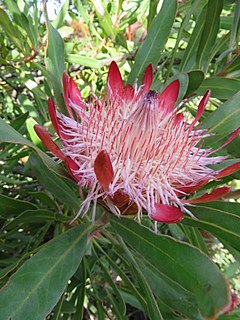
Protea susannae, also known as stink-leaf sugarbush, is a flower-bearing shrub of the genus Protea. The plant is endemic to the southwestern Cape Region of South Africa.

Protea lorifolia, in English called the strap-leaved sugarbush, strap-leaved protea or strap-leaf sugarbush is a flowering shrub which belongs to the genus Protea.

Protea wentzeliana, also known as Wentzel's sugarbush, is a shrub belonging to the genus Protea.
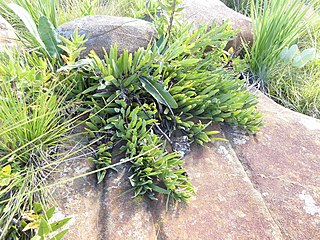
Protea parvula, also known as the dainty sugarbush, or kleinsuikerbos in Afrikaans, is a small flowering shrub belonging to the genus Protea.
















